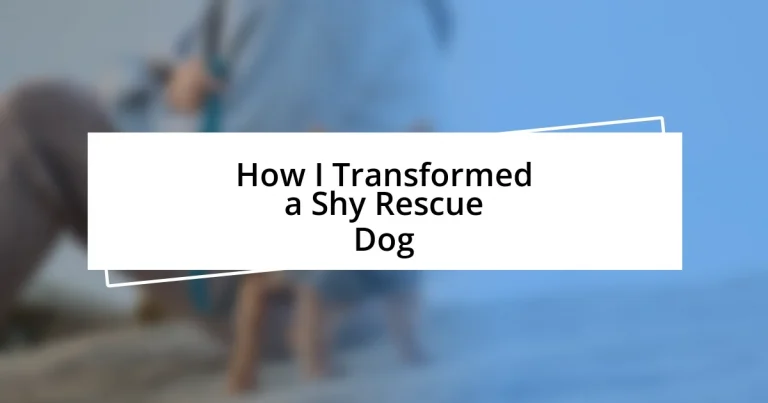Key takeaways:
- Building trust with a shy rescue dog requires patience, consistent routines, and positive reinforcement to foster a safe and confident environment.
- Recognizing signs of anxiety, such as body language and vocalizations, is crucial for understanding and addressing a dog’s fears effectively.
- Celebrating small milestones and progress boosts a dog’s confidence and strengthens the bond between the dog and owner, turning challenges into joyous moments.
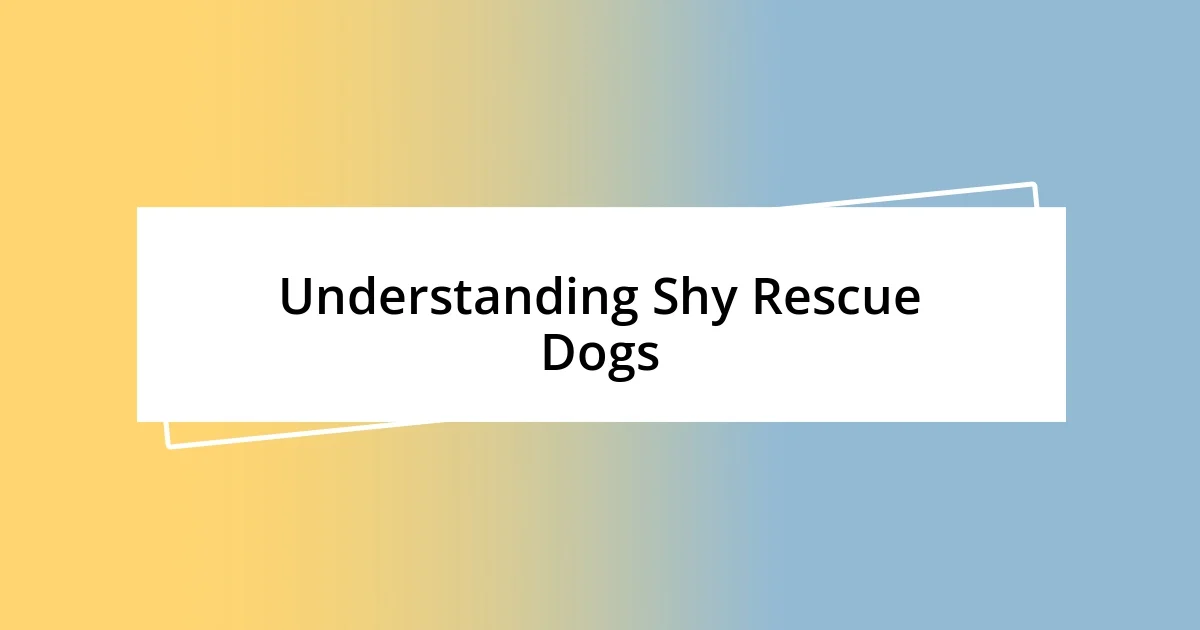
Understanding Shy Rescue Dogs
Shy rescue dogs often come from backgrounds filled with uncertainty and fear, making their behavior a reflection of their past. I remember meeting my rescue pup for the first time; she cowered in the corner, her eyes full of worry. It broke my heart to see such a gentle creature so afraid of the world. Why does she feel this way, I wondered, puzzled by her reluctance to embrace human affection?
One critical aspect of understanding these dogs is recognizing the impact of their previous environments. Many have experienced neglect or mistreatment, which can lead to deep-seated anxiety. When I gently approached my shy dog, I noticed her body language—it spoke volumes. Her tail was tucked, and she flinched at sudden movements. These signals reminded me constantly to approach her world with patience and empathy, acknowledging her fears rather than dismissing them.
Developing trust with a shy dog is a gradual process. I found that simple actions, like sitting quietly nearby or offering treats from a distance, gradually built her confidence. Each small victory—like when she took a step toward me or allowed me to pet her—felt monumental. It’s a powerful reminder that with time, understanding, and love, these timid souls can blossom into the loving companions they were meant to be. Can you imagine the joy in witnessing that transformation?
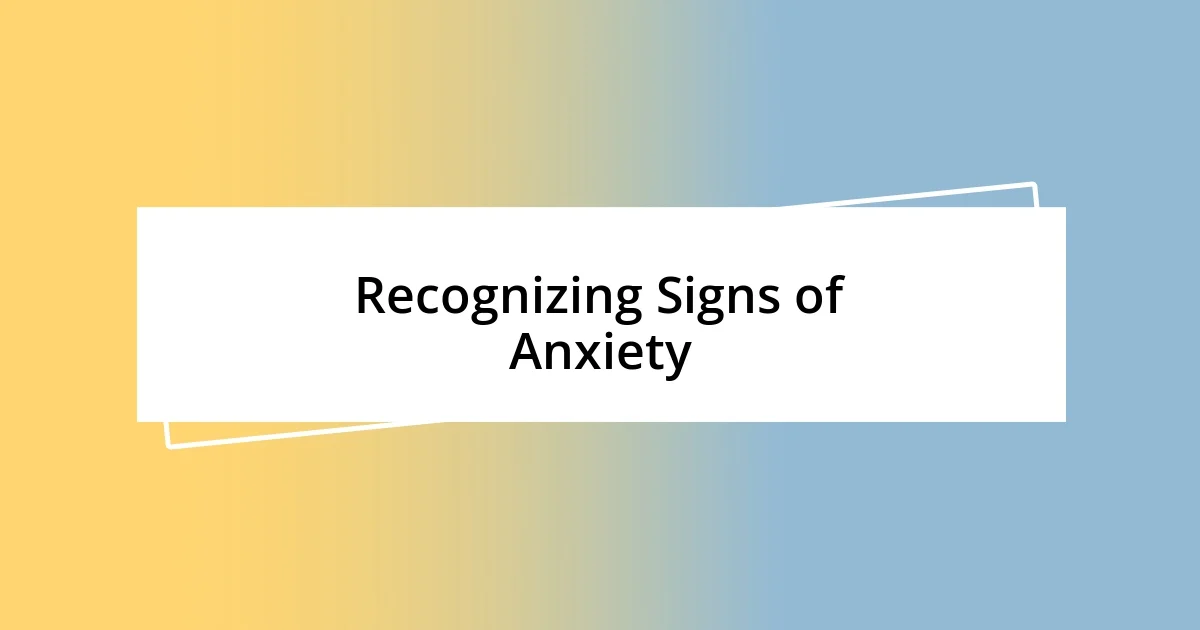
Recognizing Signs of Anxiety
When it comes to recognizing anxiety in a shy rescue dog, I’ve learned to pay close attention to subtle cues. One of the first signs I noticed in my pup was her tendency to retreat to small spaces, like under the couch or behind furniture. It’s those moments when she seeks comfort in tight spots that signal her unease, and it reminds me of how important it is to create safe, cozy areas in my home where she can feel secure. Over time, these spaces became her sanctuary, allowing her to feel not only protected but gradually more confident.
Here are some common signs of anxiety in rescue dogs:
- Tail Position: A low or tucked tail usually indicates fear or submission.
- Ear Position: Ears pinned back can signify distress.
- Body Language: A tense posture, stiff legs, or a lowered head can be telling.
- Vocalizations: Increased barking or whimpering can be signs of anxiety.
- Pacing: Restlessness or constant pacing around the room often indicates discomfort.
- Avoidance Behaviors: Hiding or turning away from people or situations shows a desire to escape.
I felt an overwhelming need to decipher these signals. After all, understanding her anxiety has been a game changer in our bond. Each acknowledgment of her feelings helped me create an environment where she could slowly learn to trust again.
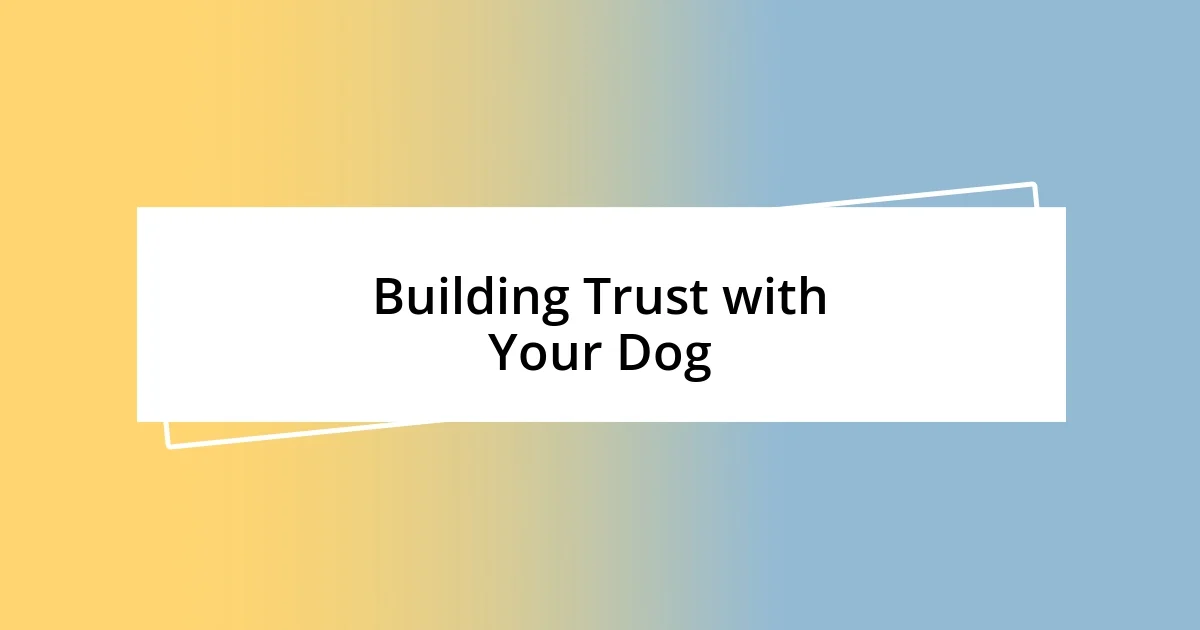
Building Trust with Your Dog
Building trust with a shy rescue dog is all about consistency and engagement. When I first started working with my pup, every interaction was a learning experience for both of us. I recall one day sitting in the living room, completely still, just reading a book while she cautiously ventured closer. It was amazing to see her brave little steps toward me, driven by curiosity rather than fear. The key is to create an atmosphere where your dog feels safe to explore their surroundings, allowing them to approach you when they’re ready.
Offering treats is another effective strategy I found immensely helpful. Initially, I tossed treats on the floor rather than directly handing them to her, which kept the experience low-pressure. Eventually, as she became more comfortable, I started extending my hand gently with treats. Each time she bravely took a treat from my hand, I felt a rush of warmth. It was as if I could physically feel her trust building—small moments that often went uncelebrated but were monumental for us both.
I also discovered the magic of routine in fostering trust. Maintaining a consistent schedule for feeding, walks, and playtime allowed her to anticipate my actions, reducing anxiety. I remember those moments when she would wait eagerly by the front door at the usual walk time—her tail wagging just a bit, a signal that she was starting to enjoy our time together. These little triumphs reassured me that our bond was growing stronger every day.
| Strategies for Building Trust | Examples from My Experience |
|---|---|
| Creating Safe Spaces | Like allowing her to curl up in her blanket fort whenever she needed a break. |
| Using Treats | Initially tossing them but then offering from my hand as she grew bolder. |
| Maintaining Routine | Learning to be there at her expected times for meals and walks. |

Implementing Positive Reinforcement
Positive reinforcement became my go-to approach when helping my shy rescue dog build confidence. I remember the first time she responded to a simple command—it’s those little victories that fueled my determination. Whenever she followed a command, I showered her with praise and a treat, instantly turning the moment into a celebration. It’s incredible how such a simple act can affirm their worth and encourage them to step out of their comfort zone.
I found that timing was everything with positive reinforcement. For instance, when she faced her fear of loud noises during a storm, I quickly distracted her with her favorite toy and rewarded her when she focused on it instead of retreating. This not only redirected her anxiety but also created a strong connection between feeling safe and being rewarded. Looking back, it makes me wonder how many other moments of anxiety in our pets could be transformed with a little bit of patience and consistency.
As I continued this journey, I discovered that varying the rewards kept her engaged. Sometimes, I used treats; other times, it was belly rubs or the chance to play tug-of-war. I vividly recall the joy in her eyes when she realized she could earn a game by simply being brave. Those moments of connection not only helped her overcome fears but also deepened the bond we were creating, teaching me that every dog is unique and deserving of personalized encouragement. What’s your dog’s favorite way to be rewarded?

Creating a Safe Environment
Creating a safe environment for a shy rescue dog is crucial to their emotional well-being. I remember setting up a cozy corner in my living room filled with soft blankets and their favorite toys. There was a sense of pride when I saw my pup finally curl up there, her little body relaxing in a space all her own. It was as if she found her sanctuary in our home, allowing her to gradually trust her new surroundings.
I also learned the importance of managing my home’s noise levels. Initially, loud sounds would send my dog running for cover. So, I made small adjustments, like dimming lights and softening music, which created a calmer atmosphere. Watching her finally lay down comfortably while I vacuumed just a few feet away was a heartwarming moment for me. Have you ever noticed how much a serene environment can help ease anxiety in pets?
Safety extends beyond the physical space. I introduced baby gates to create boundaries, helping her feel secure while still being part of the family. One day, I observed her curiously peering through the gate, tail wagging as she engaged with us from her safe zone. I realized that giving her the choice to enter or retreat at her own pace was empowering. This little shift not only made her feel secure but also started the wheels turning in her mind about exploring her world on her terms. Isn’t it fascinating how the smallest changes can have such a profound impact on our pets’ behavior?
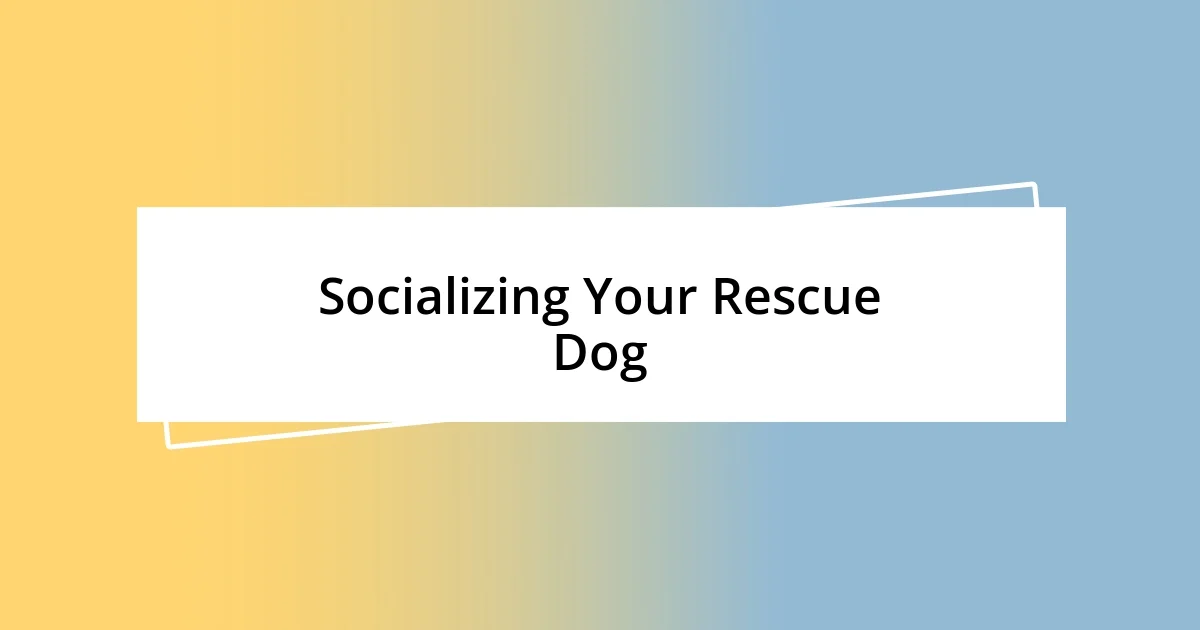
Socializing Your Rescue Dog
Socializing Your Rescue Dog
Socializing a shy rescue dog can feel daunting, but I found it to be one of the most rewarding aspects of our journey together. I remember the first time I took my pup to a park filled with people and other dogs. Her initial hesitation was palpable—she stayed close by my side, eyes wide and uncertain. But as I gently encouraged her to explore, I could see her curiosity start to awaken. Did I ever think she’d confidently trot around, tail wagging? Absolutely not! Yet, with each step, she became a little bolder.
I quickly learned that finding a buddy system was key. One sunny afternoon, I invited a friend and their calm dog over for a playdate. Watching my pup cautiously approach while I reassured her felt like a significant milestone. When she finally sniffed her new friend, I was elated; it was as if I’d witnessed the blooming of a flower. That moment reminded me that patience and the right connections can unlock a shy pup’s potential. Has your dog ever surprised you in a social setting?
As we progressed, I also made a point to expose her to various environments. From bustling cafés to quiet hiking trails, it became a learning experience for both of us. I often carried treats in my pocket, rewarding her whenever she confidently approached new situations. The joy on her face when she realized these outings were not just about conquering fears but also about having fun warmed my heart. I believe that every step, no matter how small, is a victory worth celebrating. Don’t you agree it’s all about creating those joyful moments for our dogs?

Celebrating Progress and Milestones
One of the most fulfilling aspects of my journey with my shy rescue dog was celebrating the little milestones. I vividly recall the day she tentatively approached the front door during a thunderstorm. My heart raced as she stepped closer, confident enough to explore. It was a small victory, but the sense of accomplishment was palpable. That day reminded me that every brave action, no matter how subtle, showcases growth. Don’t you feel that each of these moments deserves recognition?
I also cherished the progress she made during our training sessions. I had set a simple goal: teaching her to sit on command. On the fourth day, she finally did it! I could hardly contain my excitement as I praised her. Watching her ears perk up, and her eyes sparkle with joy was a euphoric moment for me. It wasn’t just a command learned; it was a breakthrough in her trust and confidence. Have you experienced a similar rush witnessing your pet’s newfound abilities?
Celebrating her achievements became a lovely part of our routine. After each successful outing or moment of bravery, I would reward her with her favorite treat—a tasty peanut butter biscuit. This simple ritual not only reinforced her good behavior but also created a special bond between us. I came to understand that it’s these celebrations that motivate her, transforming what could feel like daunting challenges into joyous events. How rewarding is it to see our furry friends thrive and grow?












